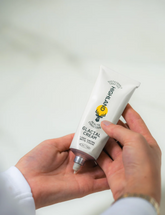
Are Silicones Bad for Hair? Here's the Truth.
Silicones are everywhere in haircare—shampoos, conditioners, and styling products. They promise smooth, frizz-free locks, but are they secretly doing more harm than good?
If you’re trying to keep your hair healthy and free from buildup, it’s time to dig deeper.
In this article, we’ll break down what silicones really do, their pros and cons, and whether you should ditch them for a better alternative. Spoiler: There’s a smarter way to get smooth, healthy hair—without the hidden downsides.
How Silicones Affect Your Hair Type
| Hair Type | What Silicones Do | What Works Better |
|---|---|---|
| Fine / Thin Hair | • Weighs hair down • Adds fake shine that turns greasy • Causes frequent buildup |
Use a lightweight, pH-balanced cleanser Keeps roots fresh without over-cleansing The Wash removes buildup—no flatness, no fuss. |
| Curly / Wavy Hair | • Blocks real moisture • Leads to brittle curls • Causes frizz once coating wears off |
Look for botanical-rich, silicone-free formulas Hydrates and defines curls naturally No transition phase—just soft, touchable texture. |
| Oily / Buildup-Prone | • Traps oil and sweat • Makes scalp greasy fast • Triggers over-washing cycle |
Use a sulfate-free, detoxifying cleanser Balances oil without irritation The Wash keeps oil in check—no harsh surfactants needed. |
What Are Silicones and Why Are They in Hair Products?
Silicones are synthetic ingredients that coat your hair, creating a protective barrier that locks in moisture and repels humidity. They’re used to:
- Tame frizz and add shine
- Make hair feel softer and smoother
- Protect against heat and humidity
- Reduce tangling and breakage
Sounds great, right? Not so fast.
Related Article: The Wash vs Shampoo
The Pros of Silicones: Why They’re Used in Haircare
Despite the bad rap, silicones aren’t all bad. Here’s why they’re popular:
- Instant Smoothness – They coat hair strands for immediate softness.
- Heat Protection – Forms a barrier against heat damage from styling tools.
- Long-Lasting Effects – Helps styles hold longer, especially in humid conditions.
If you style your hair frequently or struggle with frizz, silicones can feel like a lifesaver. But there’s a catch…
The Cons of Silicones: What’s the Downside?
While silicones give hair an instant boost, they come with hidden problems:
- Buildup Over Time – Many silicones aren’t water-soluble, meaning they accumulate on hair and scalp, leading to dull, heavy locks.
- Scalp Issues – This coating effect can trap oil, sweat, and dead skin, contributing to irritation and greasiness.
- Moisture Blocking – Instead of hydrating hair, some silicones prevent essential moisture from getting in.
- Hard to Wash Out – You need harsh, sulfate-based shampoos to remove them—stripping your hair in the process.
If your hair feels great right after washing but gets greasy or lifeless within a day, silicones may be to blame.
Water-Soluble vs. Non-Water-Soluble Silicones: What’s the Difference?
Not all silicones are equal. Some rinse out easily, while others cling stubbornly to your strands.
Type of Silicone |
Description |
Water-Soluble |
Rinse out easily, don’t cause long-term buildup (e.g., dimethicone copolyol). |
Non-Water-Soluble |
Require strong detergents to remove, can lead to product buildup (e.g., dimethicone, cyclopentasiloxane). |
If you want to avoid buildup but still enjoy smooth, manageable hair, choosing the right type of silicone is key.
Should You Avoid Silicones? Who Benefits from Going Silicone-Free?
Going silicone-free isn’t necessary for everyone, but certain hair types benefit the most:
- Fine, Thin, or Oily Hair – Silicones can make hair feel limp and greasy.
- Curly or Dry Hair – Buildup prevents moisture from penetrating hair strands.
- Sensitive Scalps – Some people experience irritation or itchiness from silicone-heavy products.
- Anyone Switching to a Clean Beauty Routine – Eliminating silicones supports long-term scalp health.
If you’re struggling with buildup, scalp issues, or lackluster hair, ditching silicones might be the best move.
How to Remove Silicone Buildup Without Damaging Your Hair
If you’ve been using silicone-based products for years, you’ll need to detox your hair before switching to a silicone-free routine. Here’s how:
- Use a clarifying shampoo (without sulfates) to break down buildup.
- Follow with a deep conditioning treatment to replenish moisture.
- Look for botanical-based cleansers to keep hair clean without harsh stripping.
- Be patient – Your hair may go through an adjustment phase as it rebalances its natural oils.
Silicone-Free Alternatives: How to Get Smooth, Frizz-Free Hair Naturally
Silicone-free doesn’t mean sacrificing performance. The best alternatives include:
- Plant-Based Oils (argan, jojoba) – Naturally smooth and nourish hair.
- Aloe Vera & Glycerin – Lock in moisture without buildup.
- Protein Treatments – Strengthen strands for long-term health.
- Silicone-Free Styling Products – Look for water-based formulas that smooth hair without synthetic coatings.
Most shampoos rely on silicones and harsh sulfates to fake smoothness, but The Wash does it differently.
- Silicone-Free, Sulfate-Free, and pH-Balanced – Cleanses without stripping.
- Removes Buildup – Keeps hair light, fresh, and naturally soft.
- Works from Day 1 – No greasy transition period, just balanced hair.
Ditch silicones, keep smooth, healthy hair—without the buildup. Try The Wash now.
The Verdict: Are Silicones Bad for Hair?
Silicones aren’t evil, but they’re not for everyone. If you’re dealing with buildup, scalp issues, or dull hair, it’s worth considering a switch to silicone-free haircare.
If you want a cleaner, healthier routine that doesn’t rely on synthetic coatings, there’s a better option.








